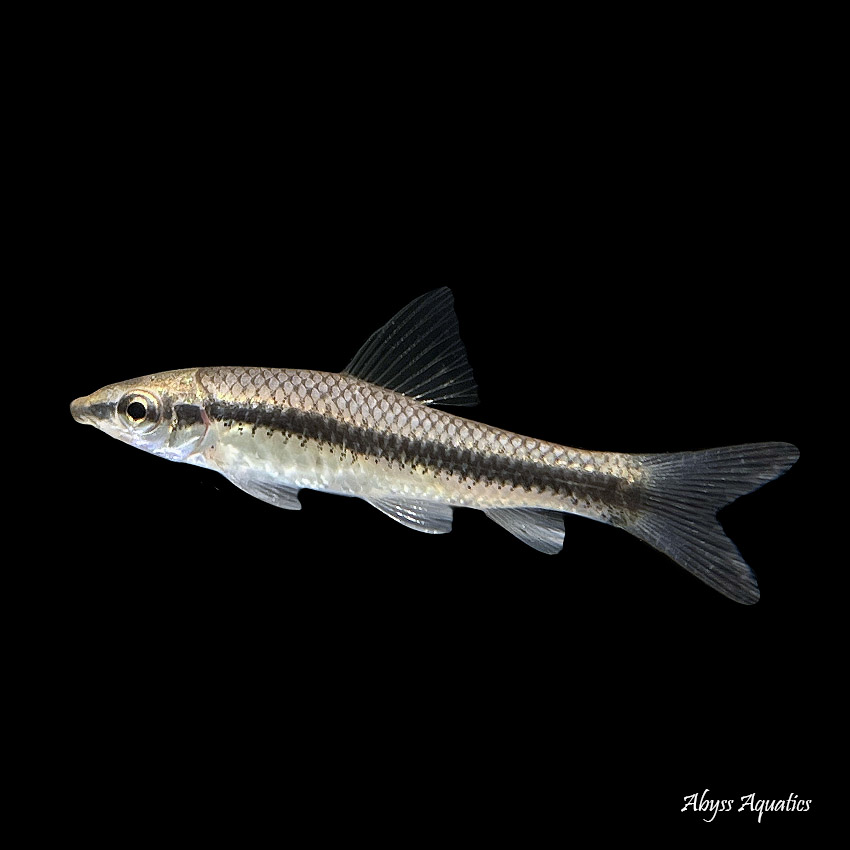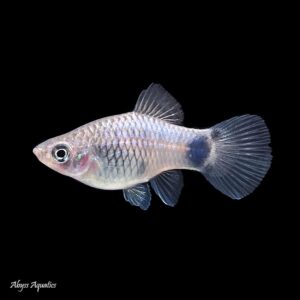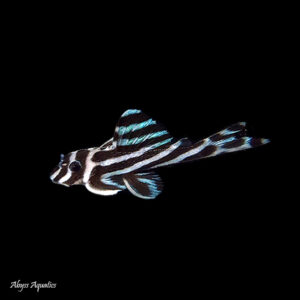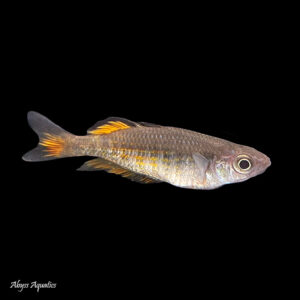The Siamese Algae Eater is a sleek and slender fish that has an elongated body shape. They have a dark, almost black, horizontal stripe that runs from the tip of their nose to the base of their tail, which helps to distinguish them from other algae-eating fish. Their dorsal fin is located towards the rear of their body and is adorned with a series of sharp spines. The rest of their fins are relatively small, and they have a pair of barbels on their mouth that help them to navigate and locate food in their natural habitat.
The Siamese Algae Eater can reach a maximum size of around 6 inches (15 cm) in the wild, although they typically do not get as large in captivity. In aquariums, they typically reach a maximum size of around 4 inches (10 cm) Their body is relatively slender, and they have a somewhat flattened appearance, which helps them to navigate through dense vegetation and rocky areas in their natural habitat. Overall, they are a sleek and agile fish that is built for swimming and manoeuvring in fast-moving water.
Their coloration can vary slightly depending on their age and habitat, but they typically have a dark grey or black coloration on their body, which is complemented by their striking horizontal stripe. Their scales have a somewhat iridescent sheen to them, which can create a shimmering effect as they move through the water. Overall, the Siamese Algae Eater is a visually striking and unique-looking fish that is sure to be a standout in any aquarium.
Siamese Algae Eaters are generally peaceful fish and can be kept with a variety of other non-aggressive species. They may become territorial towards other bottom-dwelling fish, so it’s best to avoid keeping them with other suckermouth catfish.
Natural Habitat
From a Siamese Algae Eater’s viewpoint, their natural habitat would typically consist of clear, flowing streams or rivers with rocky substrates and plenty of vegetation. The water would be well-oxygenated and have a moderate to strong current. The surrounding areas would have an abundance of plants, rocks, and fallen branches which offer hiding places and shelter from strong currents.
In these natural habitats, Siamese Algae Eaters would typically forage for food along the rocky substrate, grazing on algae and other plant matter. They would also feed on small invertebrates and insect larvae found among the vegetation. The fish would be found in groups, often swimming in midwater, but frequently moving to the bottom to feed or rest.
Overall, the natural habitat of Siamese Algae Eaters is a dynamic environment with plenty of natural features and resources, such as rocks, gravel, plants, and water current, that enable the fish to thrive. These natural elements are important to recreate in an aquarium setting to ensure the Siamese Algae Eaters are healthy and comfortable.
Keeping Siamese Algae Eaters Healthy
Siamese Algae Eaters are relatively hardy fish, but they do require specific conditions to thrive in an aquarium. They prefer water with a pH range of 6.5 to 7.5 and a temperature between 75°F and 79°F (24°C to 26°C). They also need plenty of hiding spots and live plants to graze on, as well as regular water changes to keep their environment clean.
Special Requirements and Feeding
Siamese Algae Eaters are primarily herbivores, and their diet should consist mainly of plant matter. They are known for their ability to consume large amounts of algae, but they also enjoy blanched vegetables, sinking algae wafers, and small amounts of high-quality flake or pellet food. It’s important to avoid overfeeding them, as this can lead to health problems and algae blooms.
How Many Should I Keep?
Siamese Algae Eaters are social fish and do best in groups of at least 3 or 4 individuals. Keeping them in larger groups can also help reduce aggression towards other fish and provide a more natural environment.
Lighting Preference
Siamese Algae Eaters do not have any specific lighting requirements, but they prefer a well-lit aquarium that mimics their natural environment. A moderate to high level of lighting is ideal for growing live plants, which provide them with a natural food source.
Suitable Tank Mates
Siamese Algae Eaters are generally peaceful fish and can be kept with a variety of other non-aggressive species. They may become territorial towards other bottom-dwelling fish, so it’s best to avoid keeping them with other suckermouth catfish.
Breeding Siamese Algae Eaters
Breeding Siamese Algae Eaters (Crossocheilus siamensis) can be a challenging task as they have specific requirements for successful reproduction. It is important to note that breeding Siamese Algae Eaters in a home aquarium setting can be quite difficult, and most of the Siamese Algae Eaters available in the market are wild-caught rather than bred in captivity.
Siamese Algae Eaters are known to be egg scatterers, meaning they do not provide any parental care for their eggs or fry. To encourage breeding, it is recommended to set up a spacious and well-maintained aquarium with suitable conditions.
- Water parameters: Maintain a temperature range between 75-82°F (24-28°C) and a pH level between 6.5-7.5. It is important to provide clean and well-oxygenated water.
- Tank setup: Create a suitable environment by including plenty of plants, rocks, and driftwood. These elements mimic their natural habitat and provide hiding places for the fish.
- Pairing: It can be challenging to determine the sex of Siamese Algae Eaters. However, it is believed that they may exhibit slight sexual dimorphism, with males being slightly slimmer and smaller than females. It is recommended to keep a group of Siamese Algae Eaters together and allow them to form pairs naturally.
- Feeding: Provide a balanced diet consisting of high-quality flake foods, pellets, and live/frozen foods. A varied diet helps to ensure the fish are in optimal condition for breeding.
- Spawning behaviour: Siamese Algae Eaters typically spawn during the early morning hours. The male initiates courtship by chasing the female and engaging in nipping behaviour. Once the female is ready to release her eggs, the male will follow closely, fertilizing them as they are released.
- Egg collection: If you are attempting to breed Siamese Algae Eaters, it may be necessary to provide a separate breeding tank or remove the eggs from the main aquarium. This protects the eggs from being eaten by other tank inhabitants.
- Egg care: Transfer the eggs to a separate container with similar water conditions. Provide gentle aeration and ensure the water quality remains stable. The eggs will typically hatch within 24-48 hours, depending on the water temperature.
- Fry care: Once the eggs hatch, the fry will initially feed on their yolk sacs. Afterward, you can offer them infusoria, newly hatched brine shrimp, or powdered fry food. Ensure the fry have appropriate hiding places and maintain good water quality.
Breeding Siamese Algae Eaters can be a complex process and may require specific conditions and expertise. It is recommended for experienced aquarists who are dedicated to providing the necessary care and conditions for successful breeding.
Siamese Algae Eaters have a lifespan of around 8 years in captivity when provided with proper care.
Sexual Dimorphism
Male and female Siamese Algae Eaters look very similar, and it’s difficult to tell them apart without observing their behaviour during spawning.
Lifespan
Siamese Algae Eaters have a lifespan of around 8 years in captivity when provided with proper care.
Distribution
Siamese Algae Eaters are native to Southeast Asia, including Thailand, Indonesia, and Malaysia. They are also widely available in the aquarium trade as captive-bred or line-bred strains. However, the original fish comes from the wild, and it’s important to ensure that captive-bred fish are obtained from reputable sources to avoid harming wild populations.
Summary
Overall, the Siamese Algae Eater is a peaceful and hardy fish that requires specific conditions to thrive in an aquarium. They are primarily herbivores and enjoy grazing on plant matter such as algae and other vegetation. In addition, they require a lot of swimming space, hiding spots, and clean water to remain healthy. Proper care and maintenance of the tank is essential for their well-being.
While they are not difficult to keep, they can be sensitive to water conditions and fluctuations in water parameters. It’s important to keep up with regular water changes and monitor the tank’s temperature, pH, and other factors to ensure their health.
Siamese Algae Eaters also have special requirements when it comes to feeding. They need a balanced diet that includes a mix of algae-based foods and protein-rich supplements. It’s important to provide a variety of food to ensure they get the nutrients they need.
When it comes to tank mates, Siamese Algae Eaters can be kept with other peaceful community fish that are similar in size and temperament. They may become aggressive towards other bottom-dwelling fish or those with long, flowing fins.
Overall, Siamese Algae Eaters can be a rewarding addition to an aquarium with the proper care and attention. By providing a suitable environment, feeding them a balanced diet, and keeping up with regular maintenance, they can thrive and live for up to 10 years.
Dry Goods Delivery.
The store has provided information regarding their order dispatch and estimated delivery times. Here are the key details:
- Dispatch Timeframe: Orders placed before 2pm will be dispatched on the same day. Orders placed after 2pm will be dispatched on the next working day.
- Delivery Date and Time Guarantee: While the store aims to dispatch orders promptly, they cannot guarantee a specific delivery date and time. As the delivery process relies on couriers, there may be factors beyond their control that could affect the delivery timeframe.
- 1st Class Mail: For orders sent via 1st Class mail, the aim is to have them delivered on the next working day after dispatch.
- 2nd Class Mail: Orders sent via 2nd Class mail typically take approximately 2-3 working days for delivery after dispatch.
- APC Next Day Delivery: APC Next Day delivery is available for UK mainland postcodes. It is usually delivered on the next working day after dispatch. However, please note that items being delivered to more remote areas may require additional time for delivery.
It’s important to keep in mind that while the store strives to provide efficient delivery services, unforeseen circumstances or external factors could potentially impact delivery times. For further details or specific inquiries about delivery, customers should refer to the store’s terms and conditions or contact the store directly.
Livestock Delivery.
The store maintains specific policies regarding the delivery of livestock. Here are the key points:
- Licensed Livestock Courier: The store exclusively uses a licensed livestock courier for shipping fish and coral. This approach is chosen to ensure responsible and ethical transportation of the livestock.
- Livestock Shipping Fee: The livestock shipping fee charged to customers of £19.99 does not cover the true cost, and therefore, there is a minimum spend requirement of £30.00 before the option for livestock shipping becomes available.
- Pre-Arranged Delivery: The store never ships livestock without first arranging a suitable delivery day. Before dispatching the livestock, the store must confirm the agreed-upon delivery day with the customer.
- Saturday Delivery Confirmation: Customers who choose Saturday delivery must have their availability confirmed for the upcoming Saturday before the store sends out the livestock. This confirmation ensures that the livestock can be received promptly.
- Failure to wait for livestock: Not waiting for livestock, even if there is a reasonable delay, or cancelling an order after it has been dispatched will lead to you incurring charges for an emergency return to the base. Additionally, any losses of livestock will also be charged to you. Please be aware that the items you are ordering are living creatures – livestock. We kindly ask that you refrain from ordering livestock if you are unable to accommodate the possibility of a delayed delivery.
These terms and conditions are a fundamental aspect of our policy. Our primary goal is to dissuade individuals who could react negatively to a delayed delivery and subsequently request order cancellations. It is of utmost importance to underscore that your order pertains to living creatures, not mere inanimate objects. In the event of an occasional delay, it is crucial that you respond in a rational and responsible manner, taking into account the welfare of the livestock. We kindly request that you refrain from placing an order for livestock if you tend to react strongly to such situations. By proceeding with the order of livestock, you indicate your acceptance and agreement to abide by these specified terms and conditions.
- Signature Requirement: Livestock deliveries require a signature upon receipt and cannot be left in a safe location. This precaution ensures proper handling and the well-being of the livestock.
- Geographic Restrictions: The courier has strict geographic restrictions for livestock deliveries. Unfortunately, deliveries to Northern Ireland, Republic of Ireland, Isle of Man, Isles of Scilly, Channel Islands, and certain Scottish offshore postcodes may not be possible. Customers are encouraged to contact the store via email to confirm if livestock delivery is available in their area.
- Minimum Order Value and Order Cancellations: The store has a minimum order value of £30 for livestock shipping. Additionally, the store reserves the right to cancel orders that are deemed high-risk or involve a high number of single tropical freshwater fish species.
It is essential for customers to familiarize themselves with these policies before making a purchase. For more detailed information or specific inquiries, customers should consult the store’s terms and conditions or reach out to the store directly for clarification.
Livestock Geographical Exemptions.
The store has specific geographical exemptions for livestock deliveries. Here is a list of the areas and postcodes where livestock delivery is not available:
- Islands: Livestock cannot be delivered to the Shetlands, Channel Islands, and Isle of Man.
- Postcodes: Livestock delivery is not available to the following postcodes:
- AB30 to AB39, AB41 to AB45, AB51 to AB56
- DD8 to DD10
- BT all
- DG3 to DG9, DG12 to DG14
- KA18 to KA19, KA26, KA29 to KA30
- HS all
- IM all
- JE all
- ZE all
- KW15 to KW17
- TD9
- FK17 to FK21
- GY all
- KA26, to KA28
- PA20 to PA38, PA41 to PA49, PA60 to PA61, PA76 to PA78
- TR21, to TR25
- PH3 to PH26, PH30 to PH44
- IV all
Customers residing in these areas should be aware that livestock delivery is not available to their location.
We can ship livestock to the Isle of Wight, this area is subject to a surcharge.
For further information or specific inquiries about livestock delivery to a particular area, customers are advised to contact the store directly for clarification.
Cancellation.
According to the store’s policy, customers have the right to cancel an order within 14 working days of receiving the goods. To initiate the cancellation, the goods must be returned to the store in new and unused condition, adhering to their Returns Policy.
Important points regarding the return process are as follows:
- Return Condition: The goods must be returned in new and unused condition, as originally received. It is important to ensure that the goods are in the same condition as when they were sent out.
- Return Timeframe: The goods must be received by the store within 21 days of notifying them about the cancellation. During this time, customers are responsible for any loss or damage that may occur during the return shipping process.
- Refund Process: Once the store receives the goods in new and unused condition, they will initiate the refund process. The purchase price will be refunded to the customer.
- Return Condition Inspection: If the returned goods arrive in a condition that is less than what they were sent out in, the store reserves the right to return the goods to the customer, and no refund will be processed.
It is essential for customers to carefully review the store’s Returns Policy and follow the specified procedures to ensure a smooth and successful return and refund process. For more detailed information or specific inquiries, customers should consult the store’s terms and conditions or contact the store directly.
Returns.
According to the store’s return policy, the following guidelines should be followed for returning goods:
- Use Returns Form: Customers need to use the store’s provided returns form to initiate the return process. This form helps the store acknowledge that the goods are being sent back.
- Return for Testing: If the goods are being returned for testing, the customer is responsible for covering the return shipping expenses.
- Refund of Postage Fees: The store will only refund postage fees if the order arrives damaged or becomes faulty within the first 4 weeks of purchase. Proof of posting is important, and customers should ensure the goods are well-packed and obtain proof of posting as the goods remain their responsibility until received by the store.
- Refund of Postage Costs for Replacement: If goods are being returned within 7 days of purchase under the Replacement Policy, the store can refund postage costs. However, the customer needs to agree on a delivery service with the store in advance, and only standard or tracked shipping fees will be refunded. The store cannot refund the cost of any special delivery service.
- Non-Refundable Postage: Postage costs for goods returned for any other reason than those mentioned above are non-refundable. The store reserves the right to deduct the original postage cost from any applicable refund.
- Mistaken Purchases: If a customer has made a mistake in their purchase, they need to return the goods to the store. The customer is responsible for the return shipping costs in such cases.
It is important for customers to carefully follow the store’s return procedures and terms and conditions. For further details or specific inquiries, customers should refer to the store’s website or contact the store directly.
Replacements
If customers receive faulty goods, the following guidelines apply according to the store’s policy:
- Notification of Faulty Goods: Customers must notify the store within 7 working days if they receive faulty goods. This notification should be made as soon as possible.
- Replacement Parts: If possible, the store will dispatch replacement parts for the faulty goods.
- Return of Goods: If replacement parts are not possible, the store may request customers to return the faulty goods in accordance with their Returns Policy. The specific return procedures and conditions should be followed.
- Verification of Damage: Once the store receives the returned goods, they will verify the damage. If the damage is confirmed, the store will supply the required replacements.
- Return Postage Costs: If the goods returned to the store are found to be in good working order, the store is not able to refund the return postage costs. Additionally, the store reserves the right to deduct their original postage cost from any applicable refund.
- Consequential Loss or Damage: The store cannot take responsibility for any consequential loss or damage that arises directly or indirectly from the goods supplied.
Customers should carefully review and adhere to the store’s Returns Policy and procedures for returning faulty goods. For further clarification or specific inquiries, customers should consult the store’s terms and conditions or contact the store directly.
Manufacturer’s Guarantees
The store works in collaboration with manufacturers to ensure that their guarantees are honored, and they make their best efforts to resolve issues within the warranty period. The following guidelines apply to refunds and replacements:
- Postage Costs under Manufacturer’s Guarantee: Postage costs can only be refunded if the goods are returned to the store within 7 days of the original purchase, as per the manufacturer’s guarantee.
- Refund of Postage Costs for Faulty Goods: The store will refund postage costs for guarantee/warranty returns only if the product becomes faulty within the first 4 weeks of receipt.
- Replacements with Manufacturer Authorization: Replacements, whether parts or goods, can only be offered when authorized by the manufacturer. Customers should contact the store for further guidance in such cases.
- Prior Approval for Returns: Goods should not be returned to the store without prior approval. Customers need to contact the store and obtain approval before returning any items.
- Replacement of Glass or Ceramic Items: Glass or ceramic items can only be replaced if the store is notified within 48 hours of receiving the delivery.
- Replacement of Glass Bulbs/Tubes: Glass bulbs or tubes can only be replaced if they become faulty within 14 days.
Customers should note and adhere to these guidelines to ensure a smooth and efficient resolution of any issues with their purchased items. For specific inquiries or further information, customers are advised to refer to the store’s terms and conditions or contact the store directly.
Breakages
According to the store’s policy, customers have the following responsibilities regarding breakages:
- Checking Goods on Arrival: It is the customer’s responsibility to thoroughly check the goods upon arrival for any damage. This should be done before signing for the parcel. If the parcel appears damaged, it is advised not to sign for it.
- Reporting Breakages: Any breakages or damages must be reported to the store within 48 hours of receiving the goods. It is important to promptly notify the store to initiate the resolution process.
By carefully inspecting the goods upon arrival and reporting any breakages within the specified timeframe, customers can ensure that appropriate actions are taken to address the issue. For specific instructions on reporting breakages or further information, customers should refer to the store’s terms and conditions or contact the store directly.





Sarah jane wheeler (verified owner) –
Arrived healthy…settled in quickly…I love watching them as they group together and take no notice of my larger fish…they are doing well with eating the algae.
Rebecca Freeman (verified owner) –
Happy, spritely fish! Bought them to increase my current SAE shoal, and since these new guys are very young, I kept checking to see if my larger, established ones were taking them under their wing. However it seems they’re such healthy, spunky little things that they’ve already started making light work of settling into the tank, so much so that they’re even shoving their big siblings out of the way to get best algae pickings 😂